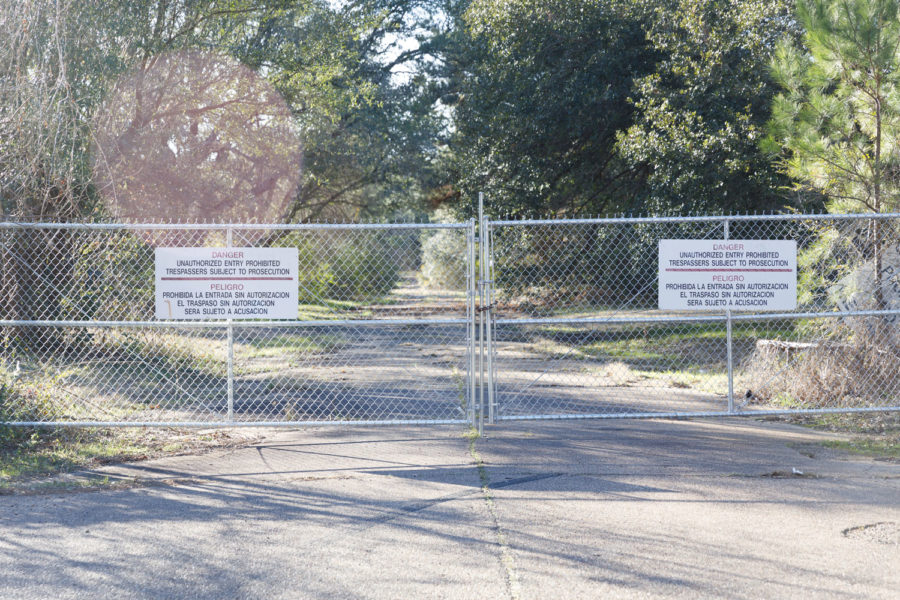Texarkana’s toxic truth
The tragic history of a Black neighborhood in Texarkana turned environmental disaster remains widely unknown and unrecognized
Photo by Clint Smith
The gate to Carver Terrace stands as the barrier between the toxic, abandoned neighborhood and the rest of Texarkana.
February 25, 2022
West Third Street: the site of an environmental tragedy right in the middle of town. From 1903 to 1961, it was Koppers Co., a wood treatment facility. In its near 60 years of its activity, it leached deadly chemicals into the ground such as creosote, zinc and polycyclic aromatic hydrocarbons. From 1964 to 1993, it was Carver Terrace, a charming, predominantly Black neighborhood in the center of Texarkana.
Since then, it has been known as one of Texarkana’s three Superfund sites: locations designated by the Environmental Protection Agency (EPA) as environmental hazards that must be cleaned up by the government. Because of this, activists related to the sites have dubbed the town “Toxicana.” What was once a prosperous, Black community has been reduced to overgrowth and tragedy at the hands of poison in the ground, leached from the wood treatment facility that once sat there.
“Everyone wants to have the American dream of living in their own home,” former Carver Terrace resident Bess Gamble-Williams said. “My mom was one of those people that saw that they were going to build a brand new brick home addition for people of color, and was passionate because when I was a little girl, they wouldn’t allow us to buy in some of the wealthier neighborhoods.”
Carver Terrace was a subdivision of 79 homes only about a mile away from where Grim Stadium is now. There was a strong sense of community and togetherness in the neighborhood. For many of the residents, it presented opportunities that were difficult to achieve at the time.
“It was just a dream of a lifetime for my mother. We were all happy. We had the dog, we had the land, the area in the backyard where my mother planted everything. We just loved it,” Gamble-Williams said. “But then, we started noticing as time went on, whenever it rained, there was always a slick on top of the water.”
However, the true nature of the land would not hide for long. Over time, sickness crept over the community.
“Pretty soon, the lives of some of our community residents started to be affected very severely,” Gamble-Williams said. “Some came up with cancers. Some of them [lost pregnancies], lost babies. I even caught a skin disease that almost took my life, and my skin boiled from the inside out. Many of us still have a lot of the ramifications from that, from living off of the land.”
Gamble-Williams believes the land was marketed to Black people intentionally. Her mother, in her environmental activism, was the first to coin the term “environmental racism:” the idea that there is environmental injustice on the basis of race.
“Why didn’t white people move there? Why didn’t they sell it to white people?” Gamble-Williams said.
At the age of 12, Gamble-Williams had developed Stevens-Johnson syndrome, a condition that “burns your body from the inside-out.” She was given only a 50/50 chance of survival.
However terrible the effects on this community were, getting the attention of the government was unfortunately difficult. At the time that things were unraveling for this community, Gamble-Williams had gone off to college. Still, her mother, Patsy Oliver, along with many other residents, fought for something to be done about the issues they were facing.
“[The community] got together; they just started complaining to the city about it. The city didn’t do anything at first until they continued to push the matter,” Gamble-Williams said. “Once they continued to push, to start getting momentum with the local newspaper, they started to talk about this. Then, that got the national attention of Greenpeace. My mom would write me and tell me about it.”
Greenpeace is an international, nonprofit, environmental advocacy organization, so getting their attention was significant. Oliver along with her neighbors and colleagues were instrumental in getting this recognized by the EPA. After initial testing on the land in 1980, it took six years to be put on the National Priorities List — for anything to be done for the residents. Meanwhile, the neighborhood continued to fall ill.
“Out of all of the communities in the country up to this day that were ever bought out, and many applied for it, only two were bought out, and Carver Terrace in Texarkana was one of them,” Gamble-Williams said. “That’s it. That’s how the government treats us.”
After years of fighting for recognition and action, the homes were bought out by the U.S. Army Corps of Engineers, and all residents were relocated by 1993. By 1996, 3,000 tons of soils and materials were removed and replaced. However, since then, little of what was promised has been done. Little proof of ongoing cleanup or any further remedial efforts exists. The former residents demand more be done to preserve what happened here, whereas it is currently left dilapidated and desolate.
“I want to make it a memorial site as well, a historical site so that anything that is done on that land can be something respectful and a memorial for those that have died,” Gamble-Williams said. “We could have something like the name of the families that were there: the Gamble family, the Davis family, the Childs family, the Watson Family, each one of them all the way down the road. I think that will be so nice to have, and maybe have a food place or ice cream place to sit down and reminisce and talk. Something like that is what I envision.”















